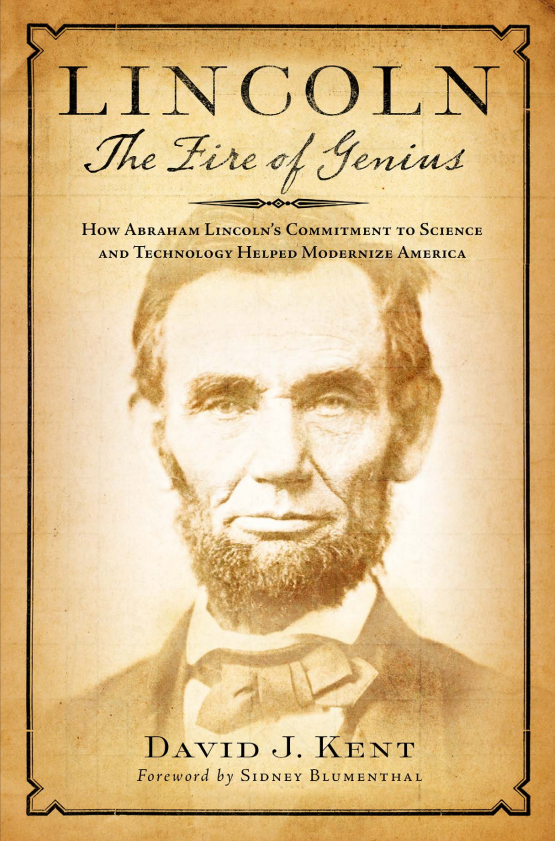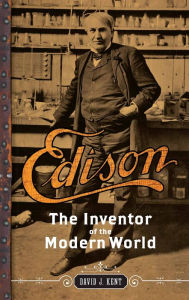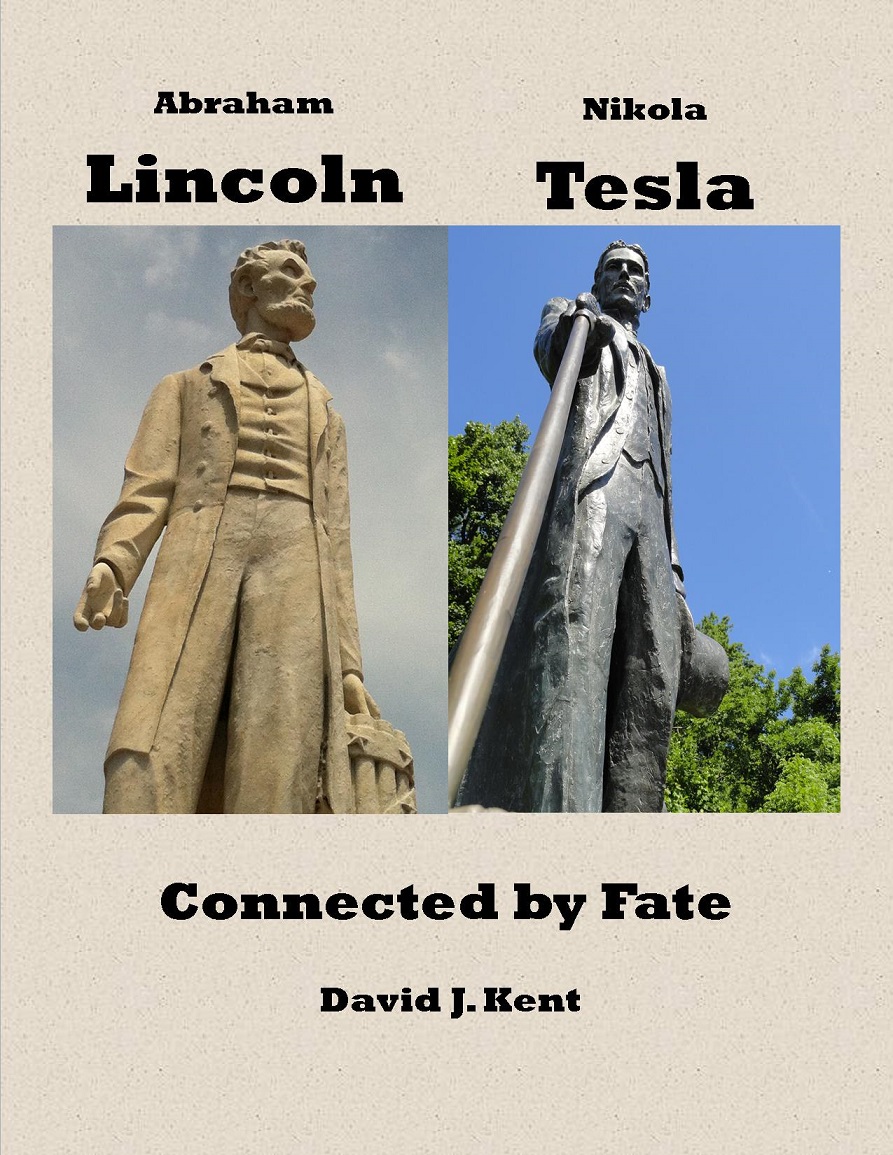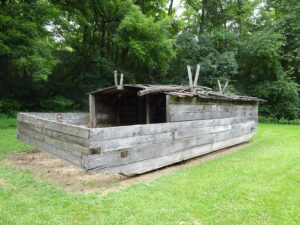 In 1828, nineteen-year-old Abraham Lincoln and neighbor Allen Gentry made what was the first of Lincoln’s two flatboat trips to New Orleans. Gentry’s father funded the trip. A typical investment required about $75 (over $2000 today) for the flatboat alone. The cargo could be worth over $3000 ($82,000 today). A successful trip could be immensely profitable; an unsuccessful one financially devastating.
In 1828, nineteen-year-old Abraham Lincoln and neighbor Allen Gentry made what was the first of Lincoln’s two flatboat trips to New Orleans. Gentry’s father funded the trip. A typical investment required about $75 (over $2000 today) for the flatboat alone. The cargo could be worth over $3000 ($82,000 today). A successful trip could be immensely profitable; an unsuccessful one financially devastating.
Building the flatboat was the first chore. Unlike keelboats, which were long and narrow with a central ridge keel under the hull to maintain stability and easy steering, flatboats were entirely flat on the bottom like a raft. They had simple square sides, with angled bow and stern. They could range from fifteen to thirty feet wide and from forty to 120 feet long. Lengthy oars called sweeps extended from the sides for stability. In the back was a wide bladed steering oar; in the front an oar called a gouger to throw the boat in any direction to avoid snags, trees, and stumps.
While that sounds simple, Gentry and Lincoln had to use their full extent of “woods craft” knowledge learned felling forests and building log cabins. One circuit riding colleague of Lincoln described the basic construction of the flatboat for that era:
Two flat pieces of timber from thirty to fifty feet in length, two to three feet in breadth, and foot in thickness were hewed out of poplar log; one edge was level, the other two were beveled at each end. These pieces were called gunwales— pronounced gunnels. Into these gunwales, at suitable distances, were mortised cross-pieces of oak, fourteen feet long, six inches wide, and three inches thick, in addition to head blocks at each end, six- or eight-inches square. A stout frame being thus made, two-inch oak planks were fastened longitudinally to the oak cross-pieces by means of wooden pins an inch square, systematically cut out from tough species of timber termed “pin oak,” and driven by a heavy maul through an auger hole bored through both planks. The bottom, consisting of two-inch oak plank, was then fastened on to these longitudinal planks and rabbeted into the gunwales, the same being made water-tight by oakum and pitch. Thus far, no iron was used in the construction, and no iron tools employed beyond crosscut saw, mill saw, an axe, broad-axe, an augur, and a draw-knife.
This boat was launched by simply turning it over by two windlasses and levers so as to lie bottom side down in the river. Uprights consisting of 4 x 4 scantling were then mortised into the upper edge of the gunwales, and one-and-one-half-inch poplar plank securely fastened longitudinally thereon, and the seams caulked with oakum, and pitched. When produce was to be her cargo, a false bottom was put in, as it was impossible to construct such boats so that they would be entirely water-tight. Finally, a ridge-pole was placed longitudinally, and a roof was added. A cabin was improvised in one corner by the use of rough boards, and four huge oars were rigged, two on the sides, one at the bow, and one at the stern. A “check post” and coil of rope were then provided, and the craft was in commission.
A small woodstove was installed for cooking. Because Lincoln and Gentry were its sole crew, their flatboat was probably about eighteen feet wide and sixty-five feet long, and they likely omitted the side sweeps, controlling the boat solely with the steering and gouger oars.
This deceptively simple boat provided a significant showcase of construction and navigation. Lincoln and Gentry had to consider structural stresses on the frame to avoid any twisting that might open up leaks between the boards. Flipping the hull into the water required an understanding of leverage and windlass, the latter being a rudimentary block and tackle, perhaps even a rope thrown over a tree branch or wooden frame. When a boat had them, sweeps needed to be almost twice as wide as the width of the hull in order to create enough physical force against the water to maintain positioning in the river. The gouger must be strong and thick enough to jab into shallow mud to jolt the flatboat to the side when necessary. Like the steering oar at the stern, the gouger required almost superhuman strength to ensure boat stability and direction. Lincoln and Gentry would use both their brains and their brawn throughout the voyage.
Most likely the two men departed Rockport in the spring to take advantage of high waters. The winter of 1828 had been rather mild, with an early spring bringing rapid tree growth. Corn crops were already beginning to grow in Louisiana. With the Ohio River cresting over its banks, the high waters offered smoother and faster sailing to the Mississippi River and on to New Orleans. The two men loaded the flatboat with James Gentry’s cargo, which included corn and hay for the mules on sugar plantations and meat and potatoes for the enslaved workers. They also likely carried “barrel pork,” a preserved pork similar to bacon that Southern planters preferred as a low-cost, high-energy food for slaves. Since much of the sugar was grown north of New Orleans in places like Natchez, Mississippi and Baton Rouge, Louisiana, the two men likely made several stops to sell their wares or barter for products they could sell further downstream, including cotton, tobacco, and sugar. The flatboat was well-battered by floating debris by the time they reached New Orleans about 1,300 miles distant. Once there, Lincoln and Gentry lingered long enough to sell their remaining stock before the flatboat was sold off to be taken apart for building houses, repairing docks, or fueling the boilers of steamboats. The two men then took a steamboat back to Rockport, Indiana.
[Adapted from Lincoln: The Fire of Genius: How Abraham Lincoln’s Commitment to Science and Technology Helped Modernize America]
[Photo credit: Flatboat display outside New Salem, IL taken by David J. Kent]
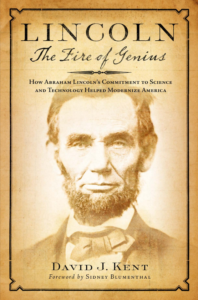
Coming in February 2026: Unable to Escape This Toil
Available now – Lincoln: The Fire of Genius: How Abraham Lincoln’s Commitment to Science and Technology Helped Modernize America is available at booksellers nationwide.
Limited signed copies are available via this website. The book also listed on Goodreads, the database where I keep track of my reading. Click on the “Want to Read” button to put it on your reading list. Please leave a review on Goodreads and Amazon if you like the book.
You also follow my author page on Facebook.
David J. Kent is Immediate Past President of the Lincoln Group of DC and the author of Lincoln: The Fire of Genius: How Abraham Lincoln’s Commitment to Science and Technology Helped Modernize America and Lincoln: The Man Who Saved America.
His previous books include Tesla: The Wizard of Electricity and Edison: The Inventor of the Modern World and two specialty e-books: Nikola Tesla: Renewable Energy Ahead of Its Time and Abraham Lincoln and Nikola Tesla: Connected by Fate.



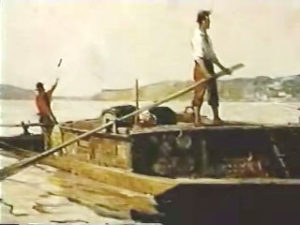 Soon after moving to Illinois, Lincoln made his second flatboat trip to New Orleans. A local entrepreneur and schemer named Denton Offutt approached Lincoln’s relative John Hanks about manning such a journey. Hanks then recruited Lincoln and brother-in-law John Johnston, all of whom now lived in a wooded area west of Decatur near the banks of the Sangamon River. Because of the previous “winter of deep snow,” melting snowpack made the roads impassable by the first of March 1831, forcing the three men to purchase a canoe and paddle down the Sangamon River as far as Springfield, where they expected to find a fully loaded flatboat. Offutt, however, had somehow forgotten to arrange for it.
Soon after moving to Illinois, Lincoln made his second flatboat trip to New Orleans. A local entrepreneur and schemer named Denton Offutt approached Lincoln’s relative John Hanks about manning such a journey. Hanks then recruited Lincoln and brother-in-law John Johnston, all of whom now lived in a wooded area west of Decatur near the banks of the Sangamon River. Because of the previous “winter of deep snow,” melting snowpack made the roads impassable by the first of March 1831, forcing the three men to purchase a canoe and paddle down the Sangamon River as far as Springfield, where they expected to find a fully loaded flatboat. Offutt, however, had somehow forgotten to arrange for it.
